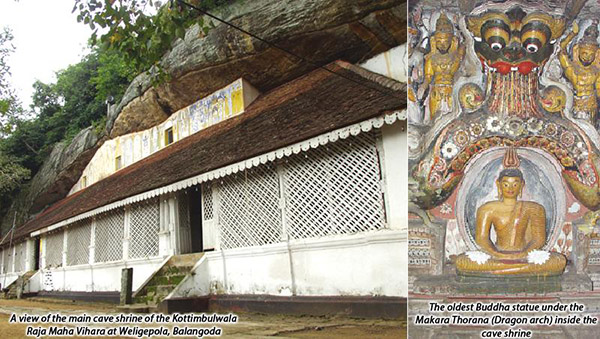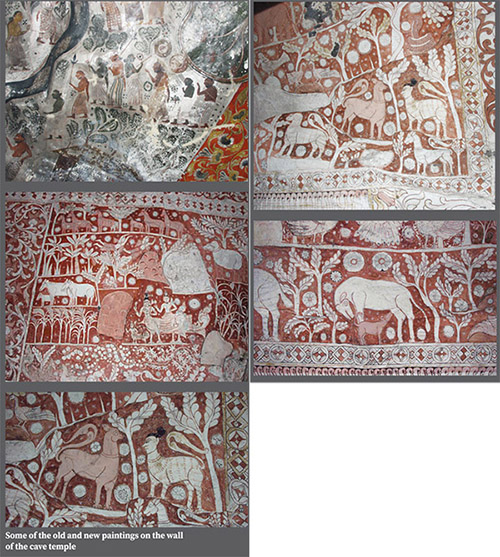Kottimbulwala Raja MahaVihara A pivotal point in history-BY MAHIL WIJESINGHE

Source:Sundayobserver
Cut off from the rest of the world, hidden by a green canopy that afford a special curtain of protection lies the Kottimbulwala Raja Maha Vihara, a little-known temple nestled in picturesque Balangoda. It is certainly the perfect setting for a temple that has been the hideout of King Walagambahu during the height of foreign invasions. With the development in the road network, reaching the temple is no longer difficult. First drive to Balangoda, an exotic rural area and 15 km from there along the Weligepola road is a village that looks green everywhere, with acres and acres of tea and paddy.
Thereafter, travel 14.5 kms on the Pallebedda-Balangoda road, taking the turn to the right from the Weligepola town and proceed a further 6.5 kms on the Kottimbulwala road to reach the Vihara.
Though the roads make Kottimbulwala Raja MahaVihara accessible, the location is not visible until one is actually there. In fact, we knew little about the Kottimbulwala Raja MahaVihara famous for its cave paintings. We had only heard that some of the paintings found on the ceiling of this cave temple had been used to illustrate a postage stamp in 1996 by the Postal Department.
The temple is small in comparison to other Sri Lankan temples, but it has a unique structure of drip-ledges cave resembling other cave temples. King Walgambahu sought refuge here as he had done in almost all the caves throughout island.
A flight of steps led the way through the temple premises up to a large grotto in a lengthy overhanging rock mass which has been converted into the cave temple. A grove of Bo-trees spread and hung over the great rock. The main cave Vihara is 120 ft. in length and 25 ft. in width.
Shrine rooms
There are several caves containing drip-ledges made into shrine rooms. It is believed that Parakramabahu VI was responsible for some of the constructions. Kottimbulwala Raja Maha Vihara is associated with the Sabaragamuwa Maha Saman Devala of Ratnapura in the performance of religious rites during the annual Saman Devala perahera.
The brow of the rock is marked with a drip ledge. Some fascinating paintings are seen on the outer side, on part of a plastered wall between the brow of the rock and the tiled roof. Under the tiled roof a trellised porch gives it a quaint and airy appearance.
Inside, leading from the airy porch the cave appears to be divided into three compartments housing three shrine rooms. At one extreme is the oldest part of the temple with its ceiling covered with ancient paintings.
In the middle compartment tucked into the alcove of the cave wall is a gigantic recumbent statue of the Buddha. We learnt that the statue was carved out of a na-imbul log and plastered over. It is also this same imbul log which formed the pillow on which the head of the Buddha rested.
This imbul log is said to have lent the name to this Vihara le – kotta – imbul or the pillow. The ceiling and walls of the shrine room too are covered with paintings.
Treasure hunters
On a side is a dagoba callously wrecked by greedy treasure hunters. Parts of the dagoba broken into pieces are seen on a side of the cave. These parts have been pasted together in the process of being reconstructed by the Archaeology Department we learnt.
In between the dagoba and the main recumbent image is an enclosed recess now a miniature shrine room with a seated Buddha statue under a Makara Thorana (Dragon arch) This is where King Walagamba hid during the time of the Cholas, we were informed. The third part of the cave also housed a series of images which seemed more recent in origin. The entrance porch that led to the three shrine rooms rested on pillars. The wooden ceiling of this part of the building is illustrated with Jathaka stories. The paintings showed the influence of colonial living apparent in the dress, ornament and motifs found in some of the paintings. The cave shrine room is quite small with an impressive history and has a quiet beauty.
The shrine room walls are covered with valuable Kandyan period murals and other styles of paintings unique to Sabaragamuwa that are some of the oldest temple paintings in the island. These paintings depict significant events from the life of the Buddha in mural form ranging from the Bodhisatva receiving blessings prior to attaining Buddhahood, his birth, marriage, and passing away. There are also rare drawings from little known Jathaka stories that are often not translated into paintings.
Traditional colour schemes have been used for the murals in subtle hues, especially when painting temples, to give the necessary subdued natural tones. According to the resident bhikkhu of the temple, the original paintings were destroyed by acts of vandalism and neglect in the past. Accordingly, the antiquated look has been replaced by the use of chemical-based paints, the single restoration that the temple has had.








